Top 3 Yoga Poses for Controlling Your Emotions
2 September Sep 2018
Let’s face it, we are emotional beings. In fact, in modern times we find that emotions rule and govern most people’s lives. A person can experience hundreds of emotional states throughout a single day.
They are fluctuating and lawless in nature and anything can trigger our emotions, from the weather to a conversation with a friend, colleague or family member, to the news and even astrological influences. We are slaves to our emotions, unfortunately.
But, did you know Yoga poses can help us to control our emotions and with emotional management?
Yoga provides a solution
The ancient system of Yoga implores us to control our emotions and provides the tools necessary to do so.
Some might ask, why would you want to control your emotions?
Because emotions are energy and energy equates to great power. When we are in control of our emotions we can use them to propel us forward in life. However, when our emotions control us we can suffer greatly and our potential will be vastly diminished.
As long as the emotions have jurisdiction over our lives we will be robbed of our natural born right to joy, unconditional love and happiness.
To be in control of your emotional landscape does not imply repression or suppression. To be in control means you have authority over your emotional state with full awareness.

Emotional management means that your emotions and emotional state do not take you by storm, but rather, you have the mental wherewithal to apply objectivity and discernment in all conditions and circumstances. In essence you are a pillar of sturdiness amidst a storm – you still feel the rain, the wind and the turbulence of the storm but you are able to remain unwavering and unshakeable in mind, body and spirit.
In Yoga there are many approaches and techniques to solve this modern dilemma of hypersensitivity and over-emotionality. This vast and comprehensive spiritual system is made up of a sum of many parts, which together create the greater whole. Meditation, Tantra Yoga, mantras, yantras, sounds, colors, vibrations, music and much more all encompass the ancient Yoga system.
Today, however, we will focus on Yoga poses, or asanas, specifically – the most popular and widely accepted tool of Yoga today.

There are asanas that help specifically with healing, digestion, courage, cultivating love, willpower, forgiveness, increased mental insight, lucidity, concentration, cleansing and purification and much, much more.
How can Yoga poses help me with my emotions?
Yoga poses are much more than just stretching exercises or silly body positions. Actually, in authentic branches of Yoga it is well known that asanas have secret meaning and mystical effects.
Asanas are in essence magical shapes that can be formed and created with our physical body. They emulate the science of sacred geometry. By putting our body in these esoteric shapes or positions we can both regulate and modulate the flow of energy within our human structure. In other words, we can divert, dam, alter and redirect the path that the energy within our body normally takes and create various intended and predetermined effects.
The magic and mystery of Yoga poses
Every Yoga pose creates different effects on the physical, mental emotional, energetic and/or spiritual levels.
If you want to create healing effects within the body there is a pose for that. Short on compassion and unconditional love? There is a pose for that. Desire more courage, dynamism and willpower? There are also several Yoga poses for that.
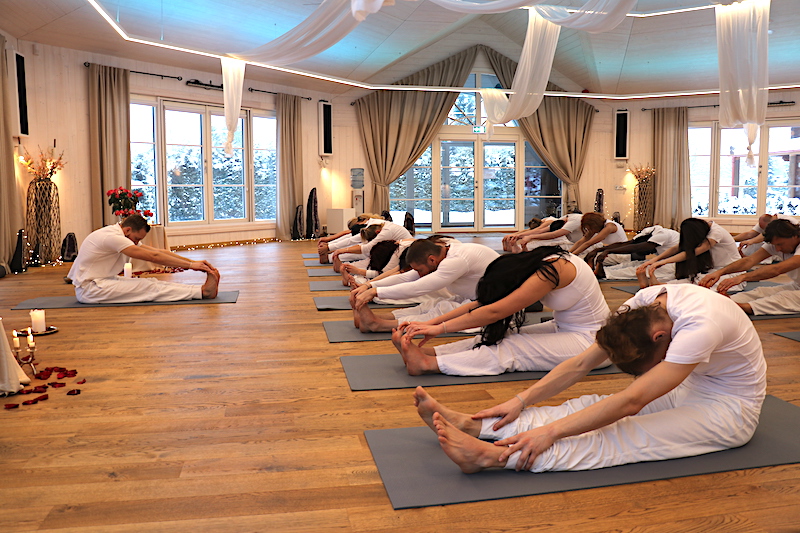
Regardless of your goals, aims or desires Yoga can help. There are asanas that help specifically with healing, digestion, courage, cultivating love, willpower, forgiveness, increased mental insight, lucidity, concentration, cleansing and purification and yes, even emotional control and management.
Today we will discuss the top three Yoga poses that can help you to harmonize your emotions and empower you to take control of your emotional domain.
DISCLOSURE
At no point should a Yoga pose cause pain. If there is pain of any kind, come out of the position immediately. Try instead to do one of the variations. In time and with practice you may find that as your physical condition changes you are better able to perform the fullest expression of the Yoga pose. Until then work within your limits and boundaries and above all be safe and gentle with yourself.
#1 Paschimottanasana
One of the easier yoga poses to perform, paschimottanasana is commonly referred to as the seated forward bend. It is well suited for the beginner and advanced practitioner alike, requiring no exceptional level of flexibility.
It works at the level of the mind which both directly and indirectly affects the state and influential potential of our emotions. This powerful asana can help to ground the mind, curb the mental processes and create a calm mindscape. Our thinking mind ultimately fuels the emotions. With a steady mind there is no ammunition to inflame our emotional state. Our emotions will submit to a fixed and powerful mind.
Execution
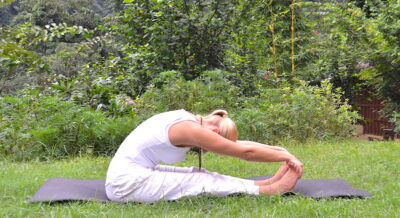
Come to a seated position on the floor, legs outstretched in front of you and completely straight. Lengthen up through the spine, reach the arms overhead and hinge forward at the hips, aiming to place the hands on the knees, shins or feet. With this yoga pose your spine does not need to remain straight or elongated. Simply relax the back and allow your head to fall between the arms. Avoid bending the knees. In order for the energy to continuously flow unencumbered through your entire being the legs must be straight and the knees locked.
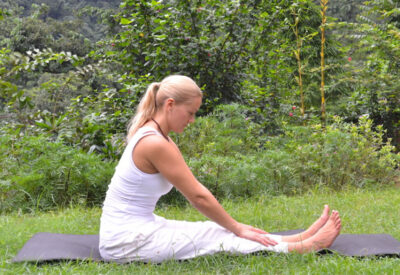
Close your eyes and concentrate your attention on your root chakra – located between the anus and testicles for men and the entrance of the vagina for women. Try to perceive earthly energies activating and arousing the root chakra. Do not let your mind waiver. If it strays from the point of concentration gently bring it back.
It is recommended to hold this asana as long as possible. If you are a beginner try holding paschimottanasana for 2 minutes continuously. For more advanced practitioners you can start with 3-5 minutes. As you adapt to the position, slowly build up your practice time. Ideally this Yoga pose is held for 15-20 minutes at a time. The longer you hold the position the greater the effects and the stronger the energy circulation.
Effects
As mentioned above, performing this Yoga pose for an extended period of time will have an effect on the mind and therefore the emotions. You may feel subtle vibrations in the area of the root chakra. Paschimottanasana can help bring great relief to those individuals that struggle or suffer with anxiety, depression, agitation, fear, paranoia and fluctuating or chaotic emotional states.
#2 Bhujangasana
Bhujangasana requires some spinal flexibility to perform in its fullest expression. However, there are variations shown below, making it accessible to most.
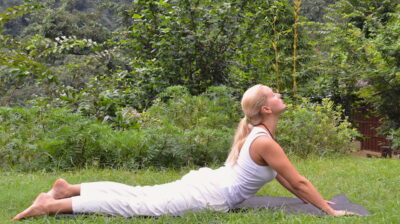
The cobra pose, as it is commonly referred to, works directly with the heart chakra, located in the center of the chest. It harmonizes and balances, cleanses and purifies and activates and arouses the heart chakra.
Additionally, bhujangasana elevates low level emotions to a higher, more dignified state. Anger can be transformed to patience; hate can transcend to love; and sadness sublimed to joy. Our emotional state becomes more refined and divine in nature and we can experience pure emotions such as compassion, universal love, contentment, gratitude and forgiveness.
Execution
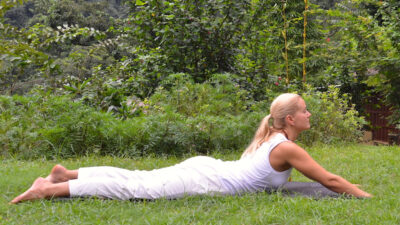
Lie down on your stomach with the legs separated. Place the palms of your hands flat on the ground directly under your shoulders. Extend the arms fully, arching the back while gently tilting the head back. If this is uncomfortable on the low back simply walk the hands forward, decreasing the degree of extension in the low spine. Find a comfortable level of performance for you which you can sustain and maintain for several minutes at a time. Alternatively, you can do the sphinx position demonstrated in the photos and titled “Variation 2”.
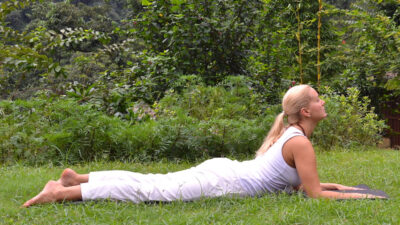
Close your eyes and focus your attention on your heart chakra. If your mind wanders away from the point of concentration simply bring it back. Due to the chaotic monkey mind that is so prevalent today, you may need to do this several times throughout the performance of this Yoga pose. Be patient, yet determined.
It is recommended to hold this asana as long as possible. If you are a beginner try holding bhujangasana for 1-2 minutes continuously. For more advanced practitioners you can start with 3-5 minutes. As you adapt to the position, slowly build up your practice time. Ideally this Yoga pose is held for 5-10 minutes continuously. The longer you hold the position the greater the effects and the stronger the energy circulation.
Effects
Bhujangasana works strongly with the heart chakra, transforming all emotional states to a more spiritual level. It serves a great purpose for modern people.
If you wish to heal a broken heart, recover from loss or emotional trauma, eliminate a bad temper or manage anger, cultivate compassion or forgiveness, discover joy and happiness and/or emanate unconditional love, bhujangasana is an incredibly powerful Yoga pose that will elevate your emotions to the next level.

How to Make a Monk Out of Your Monkey Mind
Practice is key in order to feel the effects and see results.
#3 Sarvangasana
Perhaps the most advanced or physically demanding Yoga pose of the three, sarvangasana is the shoulder stand position. Referenced as one of the top 5 most powerful asanas in many great yogic texts such as “The Yoga Sutras of Patanjali”, this Yoga pose generates sublimation through an inverted body position. Sublimation is an alchemical process whereby energy from the lower chakras of our being is raised to the higher chakras – specifically the throat chakra in this asana.
This is the best Yoga pose for converting and transmuting gross and dense energy that often characterize emotions to pure subtle energy.
Sarvangasana transforms negativity into positivity, heaviness and lethargy into vivaciousness, and despair into hope. It can be very healing and provide a serene and harmonizing effect, unifying the mind and emotions.
Execution
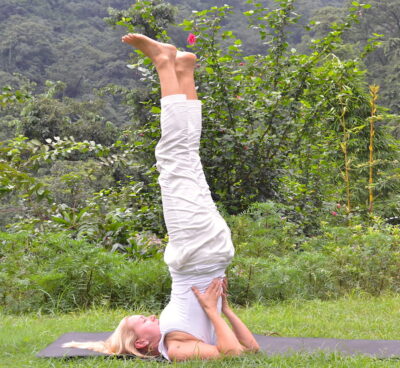
Lie on your back, raise your legs up towards your head placing your hands on your lower back for support, like a tripod or pedestal. Then, raise your legs up towards the sky, keeping the feet and legs slightly apart. Feet and legs should not touch in order to observe the polarity of energy. If being in a fully vertical position is not possible allow the legs to come down slightly and rest at a slight angle. Refer to the photos to the right for a photo demonstration.
Alternatively you can use a wall and/or pillows for support.
Close your eyes and focus your attention on the throat chakra, located at the pit of your throat. If your mind wanders away from the point of concentration simply bring it back.
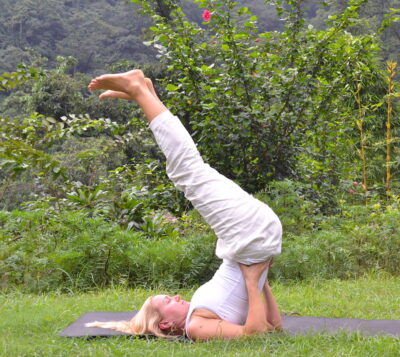
It is recommended to hold this asana as long as possible. If you are a beginner try holding sarvangasana for 1 minute continuously. For more advanced practitioners you can start with 2-5 minutes. As you adapt to the position, slowly build up your practice time. Ideally this yoga pose is held for 5-10 minutes at a time, but can even be maintained for 20-30 minutes. The longer you hold the position the greater the effects and the stronger the energy circulation.
Effects
Since our emotions are mainly contained and produced in our lower chakras (specifically the second chakra), sarvangasana can transmute this emotional energy due to its inverted nature. If you find yourself angry, depressed, overwhelmed or hopeless, perform this asana and you will immediately feel an uplifting and elevation of your emotional state and spirit. You will feel ready to tackle the issue that created the emotions in the first place with clarity and solidarity.
Meditative state of mind
As you can see our style of Yoga is not a dynamic flow moving from Yoga pose to Yoga pose. This more active type of Yoga that is common in modern times may prove to be beneficial to the physical body but does very little in changing the emotional and energetic composition of a human being.
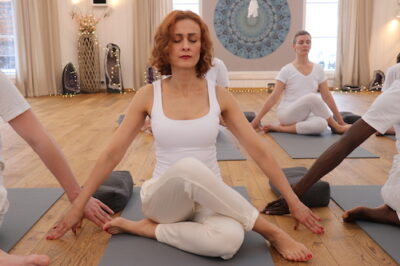
Instead, while performing the above recommended Yoga poses try your best to be still. Concentrate your mind, focus your attention and achieve a meditative state. The longer you are able to hold the asana while maintaining a fixed mind the more fruitful the practice will be and the faster the results will manifest.
Practice is key in order to feel the effects and see results. Commit to a designated amount of practice daily. Not only will you benefit greatly but you will quickly realize the freedom that accompanies mastering your emotions.
I commend you for taking powerful steps in learning emotional management and thus becoming the master of your own life. It is a path that requires effort and commitment but the results are truly extraordinary and empowering. Best of luck to you on your spiritual path!
Somananda
Founder and Head Teacher
Spiritual yogi, lecturer, teacher and author, Somananda is the founder and head teacher of Somananda Tantra School.

Discover authentic yoga here

Tantra Yoga Level 1
True Tantra starts here